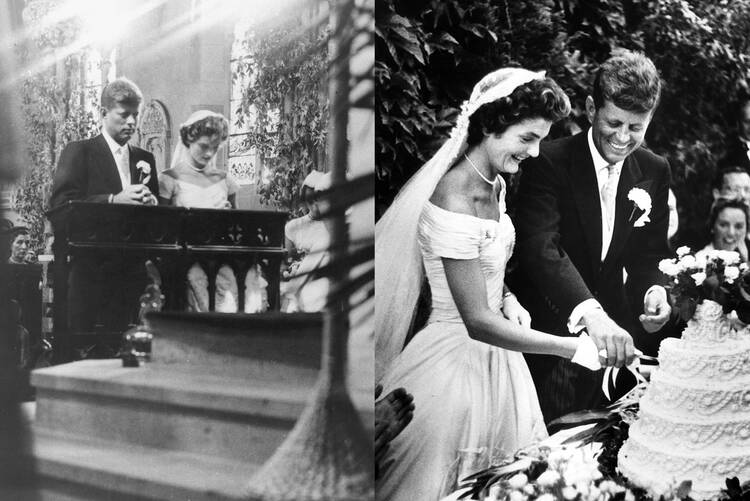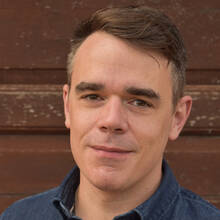In one of the most storied and moneyed seaside enclaves in the United States, a small Catholic parish recently hosted a quirky charitable event to highlight its ties to a celebrated moment in American history. The church invited parishioners, neighbors and tourists to relive the wedding of John F. Kennedy and Jacqueline Bouvier, on what would have been the couple’s 70th anniversary this month.
St. Mary, Our Lady of the Isle Church, lies in the heart of Newport, R.I., the still-bustling town where oceanic cliffs sit adorned with mansions once made famous by the wealthiest families in the United States. And while money is still present, Newport today is also home to challenges common in many summer resort towns. Houses are quickly snatched up by those seeking second or even third homes, resulting in a skyrocketing cost of living for year-round residents, many of whom can no longer afford to live here.
That might surprise visitors and tourists, but the Rev. Mark Sauriol, who has been pastor of Saint Mary’s since 2021, said that he and his parishioners understand the struggle and are doing their part to help. St. Mary’s works with other faith communities and nonprofit groups to ensure that those struggling in Newport have access to a free meal each day of the week.
In one of the most storied and moneyed seaside enclaves in the United States, a small Catholic parish recently hosted a quirky charitable event to highlight its ties to a celebrated moment in U.S. history.
“We have all the problems that every city, every community, has,” said Father Sauriol, who also pastors another Newport church, St. Augustin’s. “We have soup kitchens open everyday somewhere in Newport and every parish, every denomination, is doing something for the homeless.”
To help fund the church’s hot meal program, which re-launched last year following a hiatus during the pandemic, the parish recently hosted “Returning to Camelot,” a program featuring a documentary film and live music commemorating the wedding Mass between then-Senator Kennedy and Ms. Bouvier, who married in the church on Sept. 12, 1953.

A press release promoting the event promised an opportunity to “re-live that special day,” through a program that included “vintage film clips, a live performance of organ music and hymns from the wedding ceremony, and the ‘first dance’ played at the reception at Hammersmith Farm, Jackie’s childhood summer home in Newport.”
As I rounded the corner to enter the stone church, I prayed I wouldn’t be the only person in attendance. It was a distinct possibility, I thought, given that the wedding took place decades ago and that, with the ongoing Democratic presidential primary, perhaps Kennedy fatigue had set in. (Though admittedly, fatigue hasn’t crept into our home, where a large, modern depiction of a classic Jackie O photograph hangs in the dining room, a postcard of Jack eating an ice cream cone rests on a console and more than a dozen Kennedy books line our shelves.)
But when I entered, more than 250 other people had already settled in and organizers said another 250 had attended the afternoon program. I took a black-and-white copy of the wedding invitation (which oddly used the British spelling of “honour” on one line and the American way on another).
Boston’s Archbishop Richard Cushing, a friend of the Kennedy family, officiated the wedding, assisted by four priests, in front of about 800 people.
The setting sun streaming through the large, 19th-century, stained glass windows threatened to obscure the film presentation, but by the time the program began, the church had taken on a dusky hue.
The program was the idea of John Hirschboeck and his wife, Mary, who moved to Newport about 15 years ago. The retired ad executive was struck by the historic marker placed outside his new parish. In addition to noting that the parish, established in 1828, claims the title as the oldest in Rhode Island, the sign also reads, “President John F. Kennedy and Jacqueline Lee Bouvier were married here on September 12, 1953.”
Boston’s Archbishop Richard Cushing, a friend of the Kennedy family, officiated the wedding, assisted by four priests, in front of about 800 people. Outside the church, thousands gathered to catch a glimpse of American royalty as the couple and their guests made their way to the reception at Hammersmith Farm, Mrs. Kennedy’s childhood summer home.
On the night of the 70th-anniversary commemoration, visitors snuck a peek at the kneelers used in the Kennedy wedding, which are still in use today, and sat for a moment in pew 10, which the Kennedys occupied during their summer visits to St. Mary’s in the years after they married. An organist and choir offered live renditions of the music played during the wedding Mass, including Schubert’s Ave Maria and the hymn “To Jesus’ Heart All Burning.”
Sitting in a warm church at dusk as an organ blasts out “Here Comes the Bride”—with many in the crowd snapping their heads to look to the back of the church to see, well, nothing—felt strange. But as the roughly 40-minute program continued, I tried to suspend disbelief and just go with it. This was, after all, a fundraiser for a good cause.
Sitting in a warm church at dusk as an organ blasts out “Here Comes the Bride”—with many in the crowd snapping their heads to look to the back of the church to see, well, nothing—felt strange.
The documentary could be streamed and donations accepted via online giving. But that would have meant the hundreds of people who gathered inside St. Mary’s would not have spent time in the church, admiring its stained-glass windows and ornately carved wooden cherubs.
And being present was the point. Mr. Hirschboeck said that getting people inside St. Mary’s, regardless of their faith, had been one of his goals in showing the film, which he produced in 2014.
“People have been abandoning church-going, and it’s nice to revisit the church and maybe rekindle a flame that had kind of died out,” he said. “People can say a prayer or light a candle, almost regardless of your faith.”
Mr. Hirschboeck, who also works to promote Newport tourism, said he hopes the Kennedy program and other outreach efforts recreates the experience of visiting European cathedrals, especially for folks who might not otherwise think of spending time in a church.
“I’ve seen groups from all over the world come in and admire the architecture, and maybe there will also be a spiritual component,” he said.
Father Sauriol said he does not pine for Camelot in the same way as some of his parishioners, neighbors and visitors who remember it firsthand. (He noted during our interview that he was born a couple years after President Kennedy’s 1963 assassination.) And he is careful to note that the parish is not interested in promoting the politics of Kennedy or any other political leader, regularly saying no to journalists and historians seeking to promote books through a parish event. Aware that the Kennedys’ personal lives did not always match their carefully crafted public image, Father Sauriol also noted in the introduction to the evening’s program that the couple’s “legacy transcends their transgressions.”
Father Sauriol sees in the church’s connection to the historical wedding an opportunity for evangelization.
But he sees in the church’s connection to the historical wedding an opportunity for evangelization.
When he first arrived as pastor, Father Sauriol said, the church was locked most of the time, open only on the weekend for Mass and then occasionally for special events. People seeking to enter the church would routinely stop him in the parking lot and ask if they could visit. He got sick of saying no.
“These are my parishioners, my neighbors, business people in the community, retired people,” Father Sauriol recalled thinking to himself, people who wanted a moment of quiet, a place to pray—or even tourists looking for an opportunity to revisit history.
“I’m not going to say no to the people of God,” he said. “I’m not going to stop them from coming into the church.”
But recognizing the logistical reasons a church might not be open, including theft and vandalism, Father Sauriol asked the parish if anyone would be interested in volunteering to staff the church. Dozens of parishioners said yes. Father Sauriol was hopeful that opening the church would mean more people could spend a few minutes in quiet contemplation, especially during the hectic tourist season. The visitor log bears out his optimism. More than 8,000 people have signed in since the church opened its doors for daily visitors two years ago.
History and politics aside, Father Sauriol said being a presence in his community is most important.
“We’re just happy to be able to open up the church on a daily basis for people around the world,” Father Sauriol said. “The Catholic Church needs to be a presence in the world, even in small little communities. It needs to be a presence for everyone, not just Catholics.”







